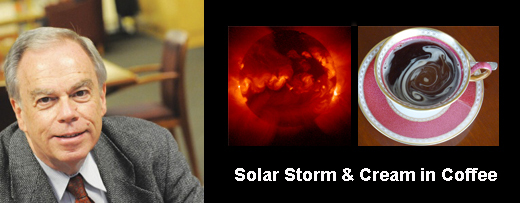What a Cup of Coffee Tells Scientists about Solar Storms

Prof. Allen Boozer was recently featured in the following Princeton Plasma Physics Laboratory press release.
He presented this work at the 54th Annual Meeting of the APS Division of Plasma Physics in Providence, Rhode Island.
| What a Cup of Coffee Tells Scientists about Solar Storms: A new theory asserts that a key astrophysical process parallels what happens at the breakfast table Magnetic fields lines in a highly conducting gas called a plasma are an explosive mix. Solar storms, which involve rapid intermixing of magnetic field lines from different parts of the outer plasma layers of the sun have disrupted power systems on Earth and interrupted satellite communications. The sudden intermixing of the lines from different sources of magnetic field, which is called magnetic reconnection, has been recognized as a central element in many astrophysical phenomena for more than 60 years. “Existing models of magnetic reconnection can be misleading,” says Allen Boozer, a Columbia University professor and long-termvisitor at the U.S. Department of Energy’s Princeton Plasma Physics Laboratory. Such models view space as if it had only two dimensions, or focus on too little of the region where reconnection takes place, as he states in a paper published in the September issue of Physics of Plasmas. When magnetic field lines from different sources are pushed together, such as lines from the sun and the Earth, electric currents naturally arise around the contour—or boundary—that separates the two sets of lines. These currents prevent the lines from intermixing but allow large amounts of energy to be stored, which is released if the field lines ever do intermix. As these currents act to prevent intermixing, they also cause the contour between the magnetic field lines to become contorted and exponentially longer—even billions of times longer—than the width of the region in which the current flows. This happens in three dimensions but not in two. Even reconnection experts are surprised by this enormous increase in the contour length, Boozer says. In a paper that has been accepted for publication in the Physics of Plasmas, he explains why this extreme contour lengthening occurs in realistic three-dimensional space but is missed by two-dimensional models. Boozer compares magnetic reconnection to what happens with cream in coffee. There is little interdiffusion—or intermixing—of the coffee and cream at first. But even a gentle stirring makes the contour between the coffee and cream grow longer and longer. Soon the length of the contour multiplied by the small distance over which coffee and cream interdiffuse equals the area across the cup—and the coffee and cream completely mix. As in the cream in coffee example, Boozer notes, the field lines in plasmas of high electrical conductivity can interdiffuse only a small distance across the contour that separates them. Nevertheless, a sudden reconnection of the lines takes place when the product of this small interdiffusion distance times the exponentially increasing length of the contour becomes comparable to the area of the region in which the electric currents flow. The primary difference between these two mixing examples is that the contour between cream and coffee lengthens as time advances. But for magnetic reconnection, the contour lengthens as the field lines are followed, at any instant of time, through the region in which the electric currents are flowing. Boozer says, gently stir your coffee and understand magnetic reconnection. Contact: John Greenwald, Princeton Plasma Physics Laboratory (609) 243-2672, [email protected] |
